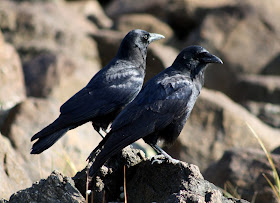By Beth Sullivan
While the Connecticut
College projects took over the blog this spring, the season bumped
along, and not very smoothly. Anybody who is a “phenologist”(
one who watches the chronology of seasonal occurrences) has surely
been keeping tabs on things this very irregular spring. Warmer
winter, short hard cold spell, intense warm up, then cold again…it
wreaked havoc on flower buds, insects and ultimately bird survival.
In the short term insectivores have been terribly stressed. In the
long term, another year of lost fruit and berries due to spring
blossom freeze will extend the stress well into the fall.
 |
| At Continental Marsh, the Ospreys have adopted the new platform |
Some interesting observations over the last erratic weeks:
Hummingbirds: The Ruby
–throated hummingbirds arrived right on time, even a hair early
this year. I had been concerned that the flowers had begun to
blossom too soon with that early warm spell, but when these fellows
arrived, the Quince was just beginning to open. However the feeders
we put out seemed very welcome, especially in the cold chill that
followed. It takes a lot of nectar or sugar water to keep those
little fires stoked. Remember to plant red flowers and get out those
annuals to give them a boost in the coming weeks.
 |
| Quince is a favored flower of Hummingbirds, but annual hanging baskets of red flowers will happily be accepted. |
 |
| Ruby-throated Hummingbirds appreciate nectar offerings when blossoms are spars. |
Purple Martins: They
are back at the Knox preserve. At least five adult males, all glossy
violet, had been staking out their favored gourds and awaiting the
arrival of the females. Then we had the week of terrible cold and
rain. Seed eating birds can survive a spell like that, but the
aerial insectivores, those who catch and eat insects on the wing like
our Martins and Tree Swallows, had a terrible time. All across CT
there were reports coming in from Martin caretakers finding dead and
dying Martins in their colonies. It is very difficult to feed these
birds. Believe it or not, some people resort to tossing mealworms
into the air, to get the birds to fly down to catch them. I checked
our colony when the cold spell was over and was thrilled to find no
fatalities. It was apparent that the birds had huddled in the gourds
for warmth. The day we were there, we saw five adult males and one
female flying and perching on their homes. We will be watching and
hoping later migrant arrivals will settle in.
 |
| We set up the housing, birds returned but were severely stressed by bad weather. |
Crows:
There are two nests within my view. I watch their nest building,
and squabbling, and antics. I watch them strut like pompous old men
across my lawn looking for edibles. And YES, they do like Cheetos as
a recent Audubon article suggested. They also have a strange practice
with earthworms. As they walk and look and maybe listen for worms
near the surface, you can just see their concentration. I watched
as a crow pulled a very long worm out of the ground, but instead of
gobbling it down Robin style, it stepped on it, and pulled off the
head ( of course I am guessing which end). It then ate that part and
left the remainder behind. This happened a great number of times
during those last rainy days. On more than one occasion, I observed
a Robin follow up and apparently grab the remainders and seem
grateful for the easy find.
 |
| Whether you love them or hate them, you have to admit crows are interesting. |
A great time of year,
no matter what the weather, as the march through spring continues and
offers us so much to enjoy.
Photographs by Beth Sullivan.

No comments:
Post a Comment